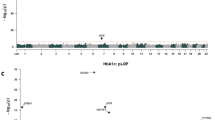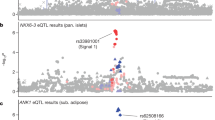Abstract
Through whole-genome sequencing of 2,630 Icelanders and imputation into 11,114 Icelandic cases and 267,140 controls followed by testing in Danish and Iranian samples, we discovered 4 previously unreported variants affecting risk of type 2 diabetes (T2D). A low-frequency (1.47%) variant in intron 1 of CCND2, rs76895963[G], reduces risk of T2D by half (odds ratio (OR) = 0.53, P = 5.0 × 10−21) and is correlated with increased CCND2 expression. Notably, this variant is also associated with both greater height and higher body mass index (1.17 cm per allele, P = 5.5 × 10−12 and 0.56 kg/m2 per allele, P = 6.5 × 10−7, respectively). In addition, two missense variants in PAM, encoding p.Asp563Gly (frequency of 4.98%) and p.Ser539Trp (frequency of 0.65%), confer moderately higher risk of T2D (OR = 1.23, P = 3.9 × 10−10 and OR = 1.47, P = 1.7 × 10−5, respectively), and a rare (0.20%) frameshift variant in PDX1, encoding p.Gly218Alafs*12, associates with high risk of T2D (OR = 2.27, P = 7.3 × 10−7).
This is a preview of subscription content, access via your institution
Access options
Subscribe to this journal
Receive 12 print issues and online access
$209.00 per year
only $17.42 per issue
Buy this article
- Purchase on Springer Link
- Instant access to full article PDF
Prices may be subject to local taxes which are calculated during checkout

Similar content being viewed by others
References
Hindorff, L.A. et al. A Catalog of Published Genome-Wide Association Studies http://www.genome.gov/gwastudies.
Kong, A. et al. Detection of sharing by descent, long-range phasing and haplotype imputation. Nat. Genet. 40, 1068–1075 (2008).
Kong, A. et al. Parental origin of sequence variants associated with complex diseases. Nature 462, 868–874 (2009).
Styrkarsdottir, U. et al. Nonsense mutation in the LGR4 gene is associated with several human diseases and other traits. Nature 497, 517–520 (2013).
Kristinsson, S.Y. et al. MODY in Iceland is associated with mutations in HNF-1α and a novel mutation in NeuroD1. Diabetologia 44, 2098–2103 (2001).
Morris, A.P. et al. Large-scale association analysis provides insights into the genetic architecture and pathophysiology of type 2 diabetes. Nat. Genet. 44, 981–990 (2012).
Sandhu, M.S. et al. Common variants in WFS1 confer risk of type 2 diabetes. Nat. Genet. 39, 951–953 (2007).
Saxena, R. et al. Large-scale gene-centric meta-analysis across 39 studies identifies type 2 diabetes loci. Am. J. Hum. Genet. 90, 410–425 (2012).
Huyghe, J.R. et al. Exome array analysis identifies new loci and low-frequency variants influencing insulin processing and secretion. Nat. Genet. 45, 197–201 (2013).
Georgia, S. & Bhushan, A. β cell replication is the primary mechanism for maintaining postnatal β cell mass. J. Clin. Invest. 114, 963–968 (2004).
Kushner, J.A. et al. Cyclins D2 and D1 are essential for postnatal pancreatic β-cell growth. Mol. Cell. Biol. 25, 3752–3762 (2005).
Emilsson, V. et al. Genetics of gene expression and its effect on disease. Nature 452, 423–428 (2008).
Eipper, B.A., Stoffers, D.A. & Mains, R.E. The biosynthesis of neuropeptides: peptide α-amidation. Annu. Rev. Neurosci. 15, 57–85 (1992).
Czyzyk, T.A. et al. Deletion of peptide amidation enzymatic activity leads to edema and embryonic lethality in the mouse. Dev. Biol. 287, 301–313 (2005).
Yin, P. et al. Probing the production of amidated peptides following genetic and dietary copper manipulations. PLoS ONE 6, e28679 (2011).
Stoffers, D.A., Ferrer, J., Clarke, W.L. & Habener, J.F. Early-onset type-II diabetes mellitus (MODY4) linked to IPF1. Nat. Genet. 17, 138–139 (1997).
Edghill, E.L. et al. Sequencing PDX1 (insulin promoter factor 1) in 1788 UK individuals found 5% had a low frequency coding variant, but these variants are not associated with type 2 diabetes. Diabet. Med. 28, 681–684 (2011).
Helgason, A. et al. Refining the impact of TCF7L2 gene variants on type 2 diabetes and adaptive evolution. Nat. Genet. 39, 218–225 (2007).
Steinthorsdottir, V. et al. A variant in CDKAL1 influences insulin response and risk of type 2 diabetes. Nat. Genet. 39, 770–775 (2007).
Jørgensen, T. et al. A randomized non-pharmacological intervention study for prevention of ischaemic heart disease: baseline results Inter99. Eur. J. Cardiovasc. Prev. Rehabil. 10, 377–386 (2003).
Thyssen, J.P., Linneberg, A., Menne, T., Nielsen, N.H. & Johansen, J.D. The prevalence and morbidity of sensitization to fragrance mix I in the general population. Br. J. Dermatol. 161, 95–101 (2009).
Lauritzen, T. et al. The ADDITION study: proposed trial of the cost-effectiveness of an intensive multifactorial intervention on morbidity and mortality among people with type 2 diabetes detected by screening. Int. J. Obes. Relat. Metab. Disord. 24 (suppl. 3), S6–S11 (2000).
Azizi, F. et al. Prevention of non-communicable disease in a population in nutrition transition: Tehran Lipid and Glucose Study phase II. Trials 10, 5 (2009).
Kutyavin, I.V. et al. A novel endonuclease IV post-PCR genotyping system. Nucleic Acids Res. 34, e128 (2006).
Albrechtsen, A. et al. Exome sequencing–driven discovery of coding polymorphisms associated with common metabolic phenotypes. Diabetologia 56, 298–310 (2013).
Pruitt, K.D., Tatusova, T., Brown, G.R. & Maglott, D.R. NCBI Reference Sequences (RefSeq): current status, new features and genome annotation policy. Nucleic Acids Res. 40, D130–D135 (2012).
Kent, W.J. et al. The human genome browser at UCSC. Genome Res. 12, 996–1006 (2002).
McLaren, W. et al. Deriving the consequences of genomic variants with the Ensembl API and SNP Effect Predictor. Bioinformatics 26, 2069–2070 (2010).
Gretarsdottir, S. et al. The gene encoding phosphodiesterase 4D confers risk of ischemic stroke. Nat. Genet. 35, 131–138 (2003).
Mantel, N. & Haenszel, W. Statistical aspects of the analysis of data from retrospective studies of disease. J. Natl. Cancer Inst. 22, 719–748 (1959).
Acknowledgements
We thank the subjects of the Icelandic deCODE study, the Danish studies and the Iranian study for their participation. We also thank the staff at the deCODE Genetics core facilities and all our colleagues for their important contributions to this work. The Danish studies were supported by the Lundbeck Foundation (Lundbeck Foundation Centre for Applied Medical Genomics in Personalised Disease Prediction, Prevention and Care (LuCamp), http://www.lucamp.org/) and the Danish Council for Independent Research. The Novo Nordisk Foundation Center for Basic Metabolic Research is an independent research center at the University of Copenhagen partially funded by an unrestricted donation from the Novo Nordisk Foundation (http://www.metabol.ku.dk/).
Author information
Authors and Affiliations
Contributions
V.S., G.T., D.F.G., A.K., U.T. and K.S. designed the study and interpreted the results. G.T., P.S., H.H., D.F.G., O.T.M., A.H., A.K. and G.M. performed analysis of sequence data, imputation and association analysis. N.G., J.M.J., M.N.H., T.H., G.T. and O.P. performed analysis and interpretation of Danish clinical and physiological data. Subject recruitment, phenotype analysis and biological material collection were organized and carried out by A.B.H., G.S. and R.B. in Iceland; T.J., A.L., M.E.J., C.C., I.B., A. Sandbæk, T.L., H.V., T.H. and O.P. in Denmark; and M.S.D., M.-S.F. and F.A. in Iran. O.T.M. and U.T. supervised sequencing and genotyping. N.G., T.H. and O.P. supervised genotyping of Danish samples. S.A.G. performed bioinformatics analyses. A. Sigurdsson, H.T.H. and H.J. performed and analyzed data from Sanger sequencing and Centaurus genotyping. G.T. and A. Sigurdsson performed and analyzed data from expression experiments. V.S., G.T., N.G., O.P., U.T. and K.S. drafted the manuscript. All authors contributed to the final version of the manuscript.
Corresponding authors
Ethics declarations
Competing interests
V.S., G.T., P.S., H.H., A. Sigurdsson, A.H., H.T.H., H.J., O.T.M., S.A.G., G.M., D.F.G., A.K., U.T. and K.S. are employees of deCODE Genetics/Amgen, Inc.
Integrated supplementary information
Supplementary Figure 1 Correlation between genotypes of rs76895963 and the expression of CCND2 in adipose tissue samples from 637 individuals.
The vertical axis shows the average relative expression, i.e. 10^(average MLR), where MLR is the mean log expression ratio, and the average is over individuals with a particular genotypes. The error bars indicate the standard error of the mean. Regressing the MLR values on the number of at-risk alleles rs76895963-G that an individual carries, adjusting for the effects of age, sex and BMI by including those as explanatory variables, yields an estimated 38% increase in expression per allele carried (P = 0.000011). All P values were adjusted for the relatedness of the individuals by simulating genotypes through the Icelandic genealogy. The resulting adjustment factors for the χ2 statistic were 1.08 for adipose. We also tested the correlation of the expression of CCND2 with all variants in a 1-Mb region centered on the gene to compare with the observed correlation with rs76895963.
Supplementary information
Supplementary Text and Figures
Supplementary Note, Supplementary Tables 1–7 and Supplementary Figure 1 (PDF 760 kb)
Rights and permissions
About this article
Cite this article
Steinthorsdottir, V., Thorleifsson, G., Sulem, P. et al. Identification of low-frequency and rare sequence variants associated with elevated or reduced risk of type 2 diabetes. Nat Genet 46, 294–298 (2014). https://doi.org/10.1038/ng.2882
Received:
Accepted:
Published:
Issue Date:
DOI: https://doi.org/10.1038/ng.2882
This article is cited by
-
Sequenced-based GWAS for linear classification traits in Belgian Blue beef cattle reveals new coding variants in genes regulating body size in mammals
Genetics Selection Evolution (2023)
-
Utility of genetic risk scores in type 1 diabetes
Diabetologia (2023)
-
PAM variants were associated with type 2 diabetes mellitus risk in the Chinese population
Functional & Integrative Genomics (2022)
-
PDX1 and MC4R genetic polymorphisms are associated with type 2 diabetes mellitus risk in the Chinese Han population
BMC Medical Genomics (2021)
-
Identification and functional study of GATA4 gene regulatory variants in type 2 diabetes mellitus
BMC Endocrine Disorders (2021)



